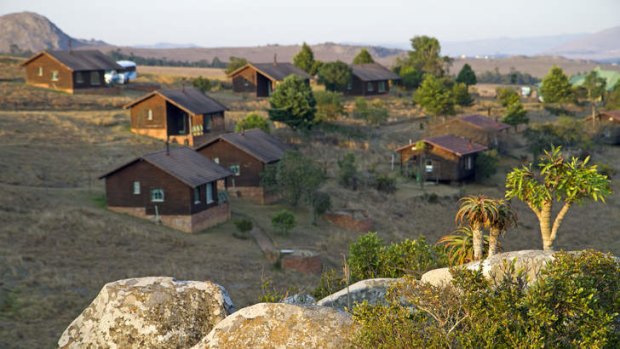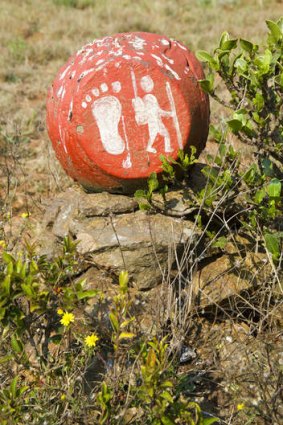
Wild at heart: Swaziland's Malolotja Nature Reserve, where flora and fauna flourish.Credit: Andrew Bain
Andrew Bain takes a hike in the hills of Swaziland.
The distance between South Africa and Swaziland is further than you might think. Though they share a border, so much separates the two countries. Cross from South Africa into Swaziland and shining shopping malls turn to dusty villages. Life expectancy rates fall and HIV rates climb. On the day I enter, newspapers are spruiking a ceremony in which Swaziland's king - Africa's only absolute monarch - will choose a teenager as his 15th wife.
But there's an undeniable beauty to the land as I drive from Swaziland's northern border into the mountains, climbing steeply above valleys terraced with crops. It could almost be an Asian scene, were it not for the blur of African dust.

Walking trail sign in Malolotja Nature Reserve.Credit: Andrew Bain
Crowning the mountains is Malolotja Nature Reserve, Swaziland's largest protected reserve. Sprawled across 18,000 hectares in the country's north-west corner, Malolotja is described by one guidebook as "Swaziland's least touristy park", with "some of the finest hiking in Southern Africa". Within an hour of setting out, I'm inclined to believe it.
Though Malolotja is near to Kruger National Park, it's not a place where you're likely to see any of the Big Five. Elephants wander a couple of its valleys and there are occasional hippo sightings but the main reason people come to Malolotja is to hike among the smaller things, such as wildflowers and birds.
The reserve has 200 kilometres of hiking trails, with 17 camps strung along the network. Just inside the park entrance, log cabins offer simple accommodation and it's here I base myself and begin walking.
The cabins sit atop a broad grassy ridge studded with boulders and the trail begins across the top of this ridge. The African heat is like a furnace and, ahead of us, a herd of blesboks trots across the trail, a reminder there's fauna here among the flora. Malolotja is said to contain more than half of Swaziland's recorded mammal species - more than 60 - as well as around 300 species of birds.
The main trail ends five kilometres from the cabins at Logwaja Lookout, a point on the ridge looking over dry valleys to a horizon stitched with blue mountains. Here the trail narrows to a thread, turning against the grain of the land to rise over a range of hills before descending steeply into gullies chiselled into its opposite flank. At their head, I can look across to 1829-metre Ngwenya Mountain, Swaziland's second highest mountain, and into the depths of the Nkomati River, which pours through the land in a series of waterfalls and gorges. Behind the mountain, out of sight, is an ancient iron-ore mine that's been dated to about 40,000BC.
The landscape on this side of the hills is all narrow folds and dark depths providing a massive contrast to the open land behind us. We lunch at the head of one waterfall, a few metres from where the river disappears into oblivion, tumbling over cliffs so steep the waterfall can't be seen even from the cliff edge.
From the waterfall, the trail turns back on itself, recrossing the hills to effectively circle a wooded canyon that's the site of Swaziland's first canopy tour - a zipline that criss-crosses from ledge to ledge, skimming across the top of the trees.
The trail loops back to Logwaja Lookout, where I sit for a while on rocks, looking over a landscape that slowly softens as the day grows old. The light is fading, the heat is dissipating and a thin band of rain cloud slides across the middle of the sky, parting the blue into neat halves. Blesboks roam an adjoining ridge, and pincushion proteas bloom like miniature suns in the grasses around me.
In the distance, it's clearly raining in South Africa but in Malolotja the rain band is moving on. Advantage Swaziland.
The writer travelled courtesy of Exodus Travels.
GETTING THERE
South African Airways has a fare to Johannesburg for about $2180 return from Sydney and Melbourne including taxes. Fly Qantas to Perth and connect with SAA to Johannesburg (11hr 30min), from where there are connections to Manzini in Swaziland. See flysaa.com.au. Australians can stay in Swaziland visa-free for up to 60 days.
TOURING THERE
Exodus Travels has a 15-day South African walking safari trip with two nights in Malolotja. Trips begin at $2885. See exodus.co.uk.
TRIP NOTES
MORE INFORMATION
Sign up for the Traveller Deals newsletter
Get exclusive travel deals delivered straight to your inbox. Sign up now.